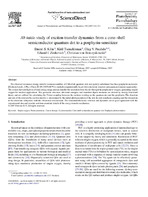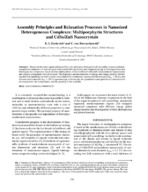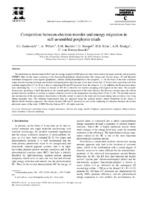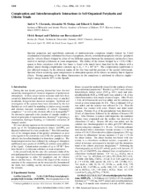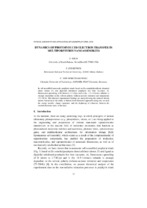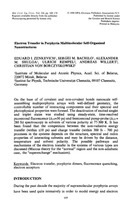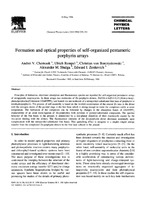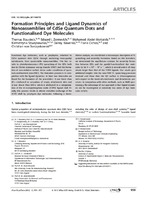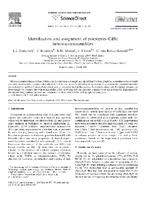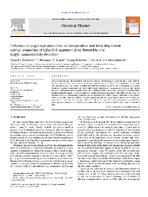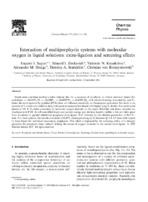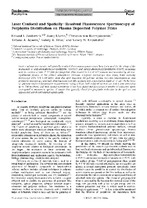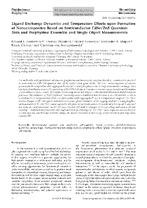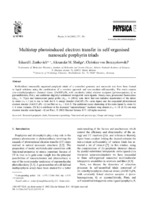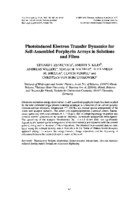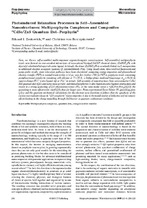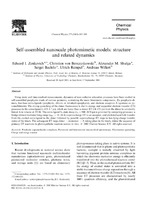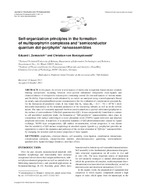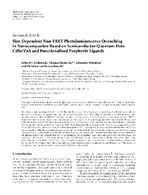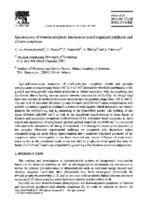Browsing Публикации в изданиях других стран by Author "Borczyskowski, C. von"
Now showing items 1-20 of 21
-
Ab initio Study of Exciton Transfer Dynamics from a Core-Shell Semiconductor Quantum-Dot to a Porphyrin-Sensitizer
Kilin, D. S.; Tsemekhman, K.; Prezhdo, O. V.; Zenkevich, E. I.; Borczyskowski, C. von (2007)The observed resonance energy transfer in nanoassemblies of CdSe/ZnS quantum dots and pyridyl-substituted free-base porphyrin molecules [Zenkevich et al., J. Phys. Chem. B 109 (2005) 8679] is studied computationally by ab initio electronic structure and quantum dynamics approaches. The system harvests light in a broad energy range and can transfer the excitation from the dot ...2017-05-27 -
Assembly principles and relaxation processes in nanosized heterogeneous complexes: Multiporphyrin structures and CdSе/ZnS nanocrystals
Zenkevich, E. I.; Borczyskowski, C. von (2009)Based on the extra-ligand addition effect, the principles of targeted self-assembly of nanosized multiporphyrin complexes of various types with controllable geometry and composition (up to 8 tetrapyrroles) and heterogeneous composites based on trioctylphosphine oxide-stabilized CdSe/ZnS semiconductor nanocrystals and organic compounds were developed. The dynamics and mechanisms ...2017-05-27 -
Competition between electron transfer and energy migration in self-assembled porphyrin triads
Zenkevich, E. I.; Willert, A.; Bachilo, S. M.; Rempel, U.; Kilin, D. S.; Shulga, A. M.; Borczyskowski, C. von (2001)The photoinduced electron transfer (ET) and the energy migration (EM) processes have been studied in liquid solutions and polymeric (PMMA) films for the triads consisting of the Zn-octaethylporphyrin chemical dimer (the energy and electron donor, D) and dipyridyl substituted tetrapyrrole extra-ligands (porphyrins, chlorin, tetrahydroporphyrin) as the acceptors, A. On the basis ...2017-05-26 -
Complexation and interchromophoric interactions in self-organized porphyrin and chlorin triads
Chernook, A. V.; Shulga, A. M.; Zenkevich, E. I.; Rempel, U.; Borczyskowski, C. von (1996)Spectral properties and equilibrium constants of multimolecular complexes (triads) formed by 2-fold coordination of dipyridyl-substituted free bases of porphyrin, chlorin, or tetrahydroporphyrin with Zn-porphyrin and Zn-chlorin dimers bridged by either of two different spacers between the monomeric entities have been studied in methylcyclohexane at room temperature. The ability ...2017-05-18 -
Dynamics of photoinduced electron transfer in multiporphyrin nanoassemblies
Kilin, D.; Zenkevich, E.; Borczyskowski, C. von (World Scientific Publishing Co., 2015)In self-assembled nanoscale porphyrin triads based on Zn-octaethylporphyrin chemical dimer (donor, D) and dipyridyl substituted porphyrin free base (acceptor, A), fluorescence quenching of D (down to 1.7-10 ps) and A (by ~1.3-1.6 times) subunits is strongly dependent on the solvent polarity (toluene-acetone mixtures) and temperature (77-350 K). The obtained experimental findings ...2017-05-27 -
Electron transfer in porphyrin multimolecular self-organized nanostructures
Zenkevich, E. I.; Bachilo, S. M.; Shulga, A. M.; Rempel, U.; Willert, A.; Borczyskowski, C. von (1998)On the base of of covalent and non-covalent bonds nanoscale self-assembling multiporphyrin arrays with well-defined geometry, the controllable number of interacting components and their spectral and photophysical properties were formed. The deactivation of excited singlet and triplet states was studied using steady-state, time-resolved picosecond fluorescence (∆½≈30 ps) and ...2017-05-25 -
Formation and optical properties of self-organized pentameric porphyrin arrays
Chernook, A. V.; Rempel, U.; Borczyskowski, C. von; Zenkevich, E. I.; Shulga, A. (1996)Principles of formation, electronic absorption and fluorescence spectra are reported for self-organized pentameric arrays of tetrapyrrolic macrocycles. In these arrays two molecules of Zn-porphyrin dimers, Zn(II)l,4-bis[5-(10,15,20-tri-p-hexylphenylporphyrinyl)]-benzene ((ZnHTPP)₂) are bound via one molecule of a tetrapyridyl-substituted free base of porphyrin or tetrahydroporphyrin. ...2017-05-25 -
Formation Principles and Ligand Dynamics for Nanoassemblies of CdSe Quantum Dots and Functionalized Dye Molecules
Blaudeck, T.; Zenkevich, E.; Abdel-Mottaleb, M.; Szwaykowska, K.; Kowerko, D.; Cichos, F.; Borczyskowski, C. von (2012)Functional dye molecules, such as porphyrins, attached to CdSe quantum dots (QDs) through anchoring meso-pyridyl substituents, form quasi-stable nanoassemblies. This fact results in photoluminescence (PL) quenching of the QDs both due to Förster resonance energy transfer (FRET) and the formation of non-radiative surface states under conditions of quantum confinement (non-FRET). ...2017-05-27 -
Identification and assignment of porphyrin-CdSe Hetero-nanoassemblies
Zenkevich, E. I.; Blaudeck, T.; Shulga, A. M.; Cichos, F.; Borczyskowski, C. von (2007)Hetero-nanoassemblies in toluene solution are formed via anchoring pyridyl substituted free base porphyrin molecules on the colloidal core-shell semiconductor nanocrystals CdSe/ZnS. The formation can be identified via quenching of semiconductor photoluminescence and followed via spectral changes of porphyrin spectral properties such as fluorescence, fluorescence decay and absorption. ...2017-05-27 -
Influence of Single Dye Molecules on Temperature and Time Dependent Optical Properties of CdSe/ZnS Quantum Dots: Ensemble and Single Nanoassembly Detection
Zenkevich, E. I.; Stupak, A. P.; Kowerko, D.; Borczyskowski, C. von (2012)Optical spectroscopy on ensembles and single CdSe/ZnS semiconductor quantum dots (QDs) demonstrates a competition of trap and near band edge photoluminescence (PL). This competition can be markedly influenced by a few surface attached pyridyl functionalized dye molecules (porphyrins or perylene diimides) forming nanoassemblies with well defined geometries. Temperature variation ...2017-05-27 -
Interaction of multiporphyrin systems with molecular oxygen in liquid solutions: Extra-ligation and screening effects
Sagun, E. I.; Zenkevich, E. I.; Knyukshto, V. N.; Shulga, A. M.; Starukhin, D. A.; Borczyskowski, C. von (2002)Steady-state and time-resolved studies indicate that for a sequence of porphyrin or chlorin chemical dimers Zn-cyclodimer → (ZnOEP)₂Ph → (ZnOEP)₂ → (ZnHTPP)₂ → (ZnOEChl)₂ with relative lowering of excited S₁- and T₁-states, the extra-ligation by pyridine (PYR) does not influence essentially on fluorescence parameters but leads to an increase of T₁-states non-radiative decay (the ...2017-05-26 -
Laser confocal and spatially-resolved fluorescence spectroscopy of porphyrin distribution on plasma deposited polymer films
Zenkevich, E. I.; Martin, J.; Borczyskowski, C. von; Ageeva, T. A.; Titov, V. A.; Knyukshto, V. N. (2008)Laser confocal microscopy and spatially-resolved fluorescence spectroscopy have been used for the study of the interaction of di(p-aminophenyl)etioporphyrin (DAPEP) and tetra(p-aminophenyl)porphyrin (TAPP) molecules with the surface of thin (7-15 μm) polypropylene films treated by 0.5 M KCl solution and activated by air non-equilibrium plasma at the normal atmospheric pressure. ...2017-05-27 -
Ligand dynamics and temperature effects upon formation of nanocomposites based on semiconductor CdSе/ZnS quantum dots and porphyrins: ensemble and single object measurements
Zenkevich, E. I.; Blaudeck, T.; Kowerko, D.; Stupak, A. P.; Cichos, F.; Borczyskowski, C. von (2012)Dye molecules with pyridyl side substituents (porphyrins and heterocyclic perylene diimides) coordinatively attached to semiconductor CdSe/ZnS quantum dots (QDs) surface form quasi-stable “QD-Dye” nanocomposites of various geometry in the competition with capping molecules (tri-n-octyl phosphine oxide or long chain amines) exchange. This results in photoluminescence (PL) quenching ...2017-05-27 -
Multistep photoinduced electron transfer in self-organised nano-scale porphyrin triads
Zenkevich, E. I.; Shulga, A. M.; Borczyskowski, C. von (2002)Well-defined structurally organised porphyrin triads of a controlled geometry andnanoscale size have been formed in liquid solutions using the combination of a covalent approach and non-covalent self-assembly. The triads contain zinc-octaethylporphyrin chemical dimer, (ZnOEP)₂Ph, with covalently linked electron acceptors (p-benzoquinone, Q or pyromellitimide, Pim), and additional ...2017-05-26 -
Photoinduced electron transfer dynamics for self-assembled porphyrin arrays in solutions and films
Zenkevich, E. I.; Kilin, D. S.; Willert, A.; Bachilo, S. M.; Shulga, A. M.; Rempel, U.; Borczyskowski, C. von (2001)Electronic excitation energy deactivation in self-assembled porphyrin triads has been studied by the time correlated single photon counting technique as a function of the solvent polarity (toluene-acetone mixtures), temperature (77-350 K), and mutual spatial arrangement of the donor and acceptor subunits. The donor (Zn-octaethylporphyrin chemical dimer) fluorescence quenching ...2017-05-26 -
Photoinduced relaxation processes in self-assembled nanostructures: multiporphyrin complexes and composites "CdSе/ZnS quantum dot-porphyrin"
Zenkevich, E. I.; Borczyskowski, C. von (2009)Here, we discuss self-assembled multicomponent organic/inorganic nanostructures. Self-assembled multiporphyrin triads were formed via non-covalent interactions of meso-phenyl bridged ZnOEP chemical dimer, (ZnOEP)₂Ph, with dipyridyl substituted tetrapyrrole extra-ligand. In tetrads, the dimer (ZnOEP)₂Ph is covalently linked via 5-mesoposition to additional electron acceptors ...2017-05-27 -
Self-assembled nanoscale photomimetic models: structure and related dynamics
Zenkevich, E. I.; Borczyskowski, C. von; Shulga, A. M.; Bachilo, S. M.; Rempel, U.; Willert, A. (2002)Using static and time-resolved measurements, dynamics of non-radiative relaxation processes have been studied in self-assembled porphyrin triads of various geometry, containing the main biomimetic components, Zn–porphyrin dimers, free-base extra-ligands (porphyrin, chlorin or tetrahydroporphyrin), and electron acceptors A (quinone or pyromellitimide). The strong quenching of the ...2017-05-26 -
Self-organization principles in the formation of multiporphyrin complexes and “semiconductor quantum dot-porphyrin” nanoassemblies
Zenkevich, E. I.; Borczyskowski, C. von (2014)In this paper, we review several aspects of molecular recognition (based on non-covalent binding interactions) occurring between meso-pyridyl substituted tetrapyrrole extra-ligands and chemical dimers of tetrapyrrolic macrocycles containing central Zn ions and spacers of various nature and flexibility. Experimental results obtained by us earlier are analyzed using a novel approach ...2017-05-27 -
Size-Dependent Non-FRET Photoluminescence Quenching in Nanocomposites Based on Semiconductor Quantum Dots CdSe/ZnS and Functionalized Porphyrin Ligands
Zenkevich, E. I.; Blaudeck, T.; Milekhin, A.; Borczyskowski, C. von (2011)We review recent experimental work to utilize the size dependence of the luminescence quenching of colloidal semiconductor quantum dots induced by functionalized porphyrin molecules attached to the surface to describe a photoluminescence (PL) quenching process which is different from usual models of charge transfer (CT) or Foerster resonant energy transfer (FRET). Steady-state ...2017-05-27 -
Spectroscopy of interchromophoric interactions in self-organized porphyrin and chlorin complexes
Zenkevich, E. I.; Shulga, A. M.; Chernook, A. V.; Rempel, U.; Borczyskowski, C. von (1995)Spectral-luminescent properties of multimolecular complexes (triads and pentads, complexation constants range from 5∙10⁶ to 5∙10⁷ M⁻¹) formed by two-fold coordination of dipyridyl and tetra-pyridyl substituted porphyrin or related molecules with Zn-porphyrin and Zn-chlorin dimers having various spacers between macrocycles (-CH₂-CH₂- or phenyl ring) have been studied in methylcyclohexane ...2017-05-18

